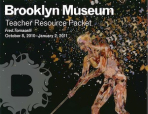
Fred Tomaselli (American, b. 1956). Big Raven, 2008. Acrylic, photocollage, and resin on wood panel, 84 × 72 in. (213.4 × 182.9 cm). Private collection, courtesy of the artist, White Cube, London, and James Cohan Gallery, New York

Fred Tomaselli (American, b. 1956). Big Raven, 2008. Acrylic, photocollage, and resin on wood panel, 84 × 72 in. (213.4 × 182.9 cm). Private collection, courtesy of the artist, White Cube, London, and James Cohan Gallery, New York

Fred Tomaselli (American, b. 1956). Untitled (Expulsion), 2000. Leaves, pills, insects, acrylic, photocollage, and resin on wood panel, 84 × 120 in. (213.4 × 304.8 cm). Collection of Peter Norton
Revisiting a scene from the Book of Genesis, Tomaselli renders the Garden of Eden with a psychedelic combination of flowers, plants, butterflies, insects, leaves, smiling mouths, and hands. Many of these elements appear to blast from a fiery vortex, suggesting a divine presence, while Adam and Eve sorrowfully depart from the garden. Around 2000, Tomaselli introduced figures into his work, often with their skin peeled away to reveal the circulatory system. The artist regards the expulsion from paradise as one of the central myths that informs our impulse to seek utopia—an impulse that often leads to disaster. He notes that in our attempt to return to paradise, we usually end up further from it than ever (a theme also explored in Desert Bloom).
_600_599.jpg)
Fred Tomaselli (American, b. 1956). Desert Bloom, 2000. Photocollage, acrylic, and resin on wood panel, 60 × 60 in. (152.4 × 152.4 cm). Collection of Martin and Rebecca Eisenberg
Radiating from a central point, this painting traces a network of dotted lines that seems to expand beyond the edges of the painting into the infinity of space. In the center of the web is a cluster of buildings including representations of the author Henry David Thoreau’s cabin on Walden Pond, the shack where Ted Kaczynski (a.k.a. the Unabomber) lived, and the cult leader David Koresh’s compound at Waco, Texas. The connections are open to interpretation, but may be related to a unique brand of American individualism that seeks simplicity and spiritual enlightenment in utopian quests that sometimes devolve into messianic behavior or antiauthoritarianism. Tomaselli feels that this piece explores the ways American society imposes ideology onto landscape.

Fred Tomaselli (American, b. 1956). Echo, Wow, and Flutter, 2000. Leaves, pills, photocollage, acrylic, and resin on wood panel, 84 × 120 in. (213.4 × 304.8 cm). Albright-Knox Art Gallery, Buffalo, New York. James G. Forsyth Fund
This piece is part of a series Tomaselli began in 2000 based on catenaries (curves formed by hanging a rope or chain between two points). Densely overlapping strands loop horizontally across the picture’s surface, creating a dynamic abstract composition around a central vertical axis. The strands resemble festive garlands or extraordinarily large beaded necklaces laboriously pieced together from brightly hued capsules and caplets; cutout images of eyes, lips, hands, flowers, and insects; leaves from hemp and datura plants; and painted areas of lozenges, circles, and jagged flame-like shapes. These strands might also be interpreted as waves of sound or energy made visible.
Fred Tomaselli
October 8, 2010–January 2, 2011
This focused mid-career survey presents a selection of Fred Tomaselli’s unique hybrid paintings and collages from 1990 to the present. These layered paintings combine cutout images of plants, birds, smiling mouths, and hands (clipped from field guides and magazines) with passages of paint and actual prescription pills and hallucinogenic plants to create highly stylized, eye-popping compositions. Tomaselli’s artwork draws upon a wide range of sources from both popular culture and art history, and from his own hobbies of gardening, kayaking, and bird-watching. Growing up near the desert in southern California, Tomaselli felt the influence of nearby theme parks, with their manufactured reality, and the music and drug counterculture of Los Angeles in the 1970s and 1980s. His distinctive melding of these influences coalesces into a folk-driven, utopian vision of the mythic American West and of lush gardens as sites of contemplation, loss, and possible redemption. One of the pioneering artists who moved to Williamsburg, Brooklyn, in the 1980s, Tomaselli continues to live and work in the borough.
This exhibition is organized and toured by the Aspen Art Museum and The Frances Young Tang Teaching Museum and Art Gallery at Skidmore College. The Brooklyn Museum presentation is coordinated by Eugenie Tsai, John and Barbara Vogelstein Curator of Contemporary Art, Brooklyn Museum.
Presenting sponsor
The exhibition has also received support from Sotheby’s; Glenstone; James Cohan Gallery; The Susan and Leonard Feinstein Foundation; White Cube, London; Amanda and Glenn Fuhrman; Amy and John Phelan; Mickey Cartin; Greg Feldman and Melanie Shorin; Scott and Meg Mueller; and other generous donors.
Media sponsor



